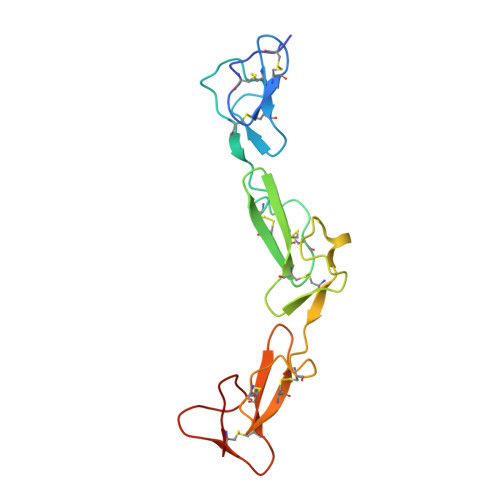Structural and Functional Characterization of a Novel T Cell Receptor Co-Regulatory Protein Complex, Cd97-Cd55.
Abbott, R.J.M., Spendlove, I., Roversi, P., Fitzgibbon, H., Knott, V., Teriete, P., Mcdonnell, J.M., Handford, P.A., Lea, S.M.(2007) J Biological Chem 282: 22023
- PubMed: 17449467
- DOI: https://doi.org/10.1074/jbc.M702588200
- Primary Citation of Related Structures:
2BO2, 2BOU, 2BOX - PubMed Abstract:
CD97, the archetypal member of the EGF-TM7 protein family, is constitutively expressed on granulocytes and monocytes and rapidly up-regulated on T and B cells following activation. The key isoform of CD97 expressed on leukocytes binds the complement regulatory protein CD55 (also termed decay-accelerating factor). CD97 has been shown recently to mediate co-stimulation of T cells via CD55. Here, we demonstrate that blocking the interaction between CD55 on monocytes and CD97 on T cells leads to inhibition of proliferation and interferon-gamma secretion. This implies that bidirectional interactions between CD97 and CD55 are involved in T cell regulation. Structural studies presented here reveal the molecular basis for this activity. We have solved the structure of EMR2, a very close homolog of CD97, using x-ray crystallography. NMR-based chemical shift mapping of the EMR2-CD55 interaction has allowed us to generate a model for the CD97-CD55 complex. The structure of the complex reveals that the T cell and complement regulatory activities of CD55 occur on opposite faces of the molecule. This suggests that CD55 might simultaneously regulate both the innate and adaptive immune responses, and we have shown that CD55 can still regulate complement when bound to CD97.
- Sir William Dunn School of Pathology, University of Oxford, South Parks Road, Oxford, UK.
Organizational Affiliation:


















